SLNS Sagara: the Nation’s Guardian at Sea
July 13, 2021SLNS Sagara: the Nation’s Guardian at Sea
By Dishan Joseph
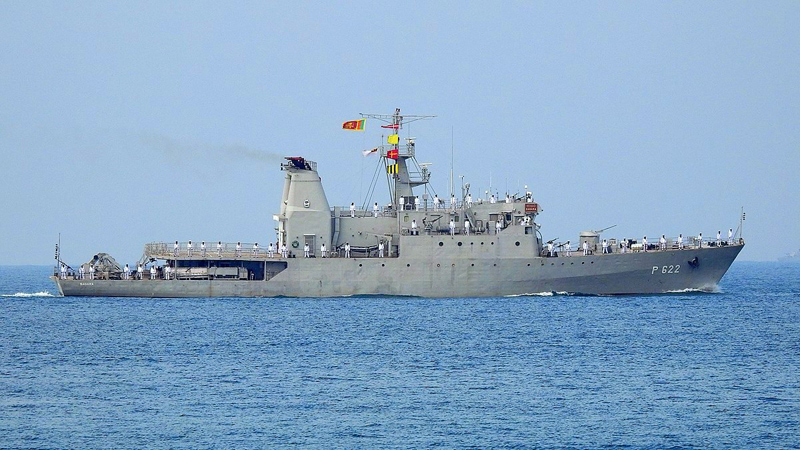
A few years ago, I remember the following words inscribed on a wooden plaque, a quote by Joseph Conrad which best captures the role of a naval captain at sea - “There is one who alone is ultimately responsible for the safe navigation, engineering performance, accurate gunfire and morale of his ship. This is the most demanding assignment of the Navy.”
In this narrative, we discover the Offshore Patrol Vessel (OPV) named SLNS Sagara (P-622). My first visit took place when she was berthed at the Naval Dockyard in Trincomalee. The then Commanding Officer was Captain Anura Dhanapala. My second visit was made when she was docked in Colombo. Her present Commanding Officer is Captain H.B.K. Manjula. When we talk about coastal defences and maritime security, the Navy has the onerous responsibility to protect our borders. The Sri Lanka Navy has a fleet of Offshore Patrol Vessels which venture out into the deep sea.
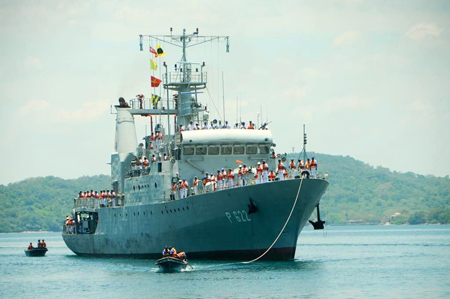 One bright Friday morning, when the rays of the sun flashed out in splendour over the coast, I made my entry along the gangway, following a chief petty officer. The vessel SLNS Sagara was built in India in 1991 and given to Sri Lanka in February 2006. During the time she was inducted into service, she dominated the ocean, prior to the arrival of new Advanced Offshore Patrol Vessels. SLNS Sagara has a displacement of 1,367 tonnes with a length of 74.8 metres and a width of 8.4 metres. The crew consists of 120 men. As we walked up the gangway, seagulls hovered above us. I was greeted by the gangway guard which was made up of a duty petty officer, guard commander and a quartermaster. It was impressive to see the polished, wood-panelled walls of the captain’s office (cabin), in contrast to the traditional dark grey paint that often coats naval vessels across the globe.
One bright Friday morning, when the rays of the sun flashed out in splendour over the coast, I made my entry along the gangway, following a chief petty officer. The vessel SLNS Sagara was built in India in 1991 and given to Sri Lanka in February 2006. During the time she was inducted into service, she dominated the ocean, prior to the arrival of new Advanced Offshore Patrol Vessels. SLNS Sagara has a displacement of 1,367 tonnes with a length of 74.8 metres and a width of 8.4 metres. The crew consists of 120 men. As we walked up the gangway, seagulls hovered above us. I was greeted by the gangway guard which was made up of a duty petty officer, guard commander and a quartermaster. It was impressive to see the polished, wood-panelled walls of the captain’s office (cabin), in contrast to the traditional dark grey paint that often coats naval vessels across the globe.
After formal greetings, the captain introduced me to the ship’s gunnery officer who obligingly conducted the tour of the vessel. We walked through a passage and a hatch led us to the ship’s forecastle which is the upper deck, forward of the foremast. This area comes under the direct responsibility of the gunnery officer, in keeping with the sailing traditions of the British Admiralty. The ship’s primary armament - the 30 mm Medak Gun is mounted on this position. The rotating gun manned by two sailors has an effective firing range of 4,000 metres and an air target range of 2,000 metres. During live firing, the gunners get orders from the bridge via the “guncomm” communication system. The gun crew is put on rotating shifts to keep the gunners alert and physically stable when engaging enemy targets. The vessel’s firepower is further augmented by 12.7 mm mounted weapons which have a range of 6,765 metres. SLNS Sagara also has a helipad. When engaging a flotilla of enemy craft, the gunnery officer can call in his “fire team”. These sailors, wielding their machine guns, will create a “suppressing firewall” towards the approaching threat, creating an extra platform of gunfire. These tactics were successfully deployed by the Navy to neutralise LTTE Sea Tiger attacks in the past. The forecastle also houses the heavy anchor, connected to seven shackles (each shackle is 27 metres long). The anchor is lowered only on the command of the captain.
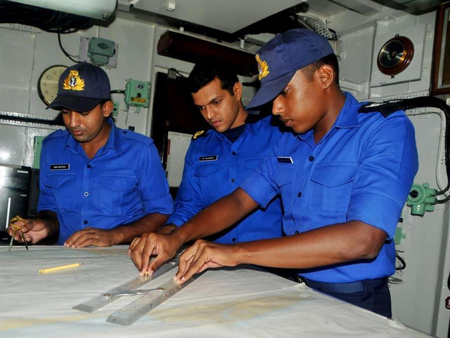 Naval terminology may be confusing to laymen. For a start, the left side of a vessel is known as the portside (indicated by red) and the right side is known as the starboard (indicated by green). The kitchen is called a galley, and toilets are referred to as heads. I also learnt from an officer about one of the meanings attached to the word NAVY- Neat, Able-bodied, Valiant, Yachtsmen. Centuries ago, the British Navy had trained its seamen on basic sailing using sturdy yachts. SLNS Sagara sails on routine patrol travelling almost 200 Nautical Miles into the blue ocean. Discipline and teamwork are a must to maintain the vessel at effective operational levels. Many naval departments work on board as a family to ensure this.
Naval terminology may be confusing to laymen. For a start, the left side of a vessel is known as the portside (indicated by red) and the right side is known as the starboard (indicated by green). The kitchen is called a galley, and toilets are referred to as heads. I also learnt from an officer about one of the meanings attached to the word NAVY- Neat, Able-bodied, Valiant, Yachtsmen. Centuries ago, the British Navy had trained its seamen on basic sailing using sturdy yachts. SLNS Sagara sails on routine patrol travelling almost 200 Nautical Miles into the blue ocean. Discipline and teamwork are a must to maintain the vessel at effective operational levels. Many naval departments work on board as a family to ensure this.
The Engine Room is the heart of SLNS Sagara, generating continuous power that propels her to a speed of 19 knots. The officer in charge of this area explained that two 16-cylinder engines release 6,400 horsepower. The diesel-driven engines require daily checks and readings. Next to the engines is the MCR - Machinery Control Room where the throttles are located (in addition to the throttles on the bridge). The engineering section provides fire-fighting capacity to the OPV and uses a Halon fire-fighting system. I observed many pipelines painted in various colours for easy recognition. Another vital duty performed by the Engineering Branch is the conversion of seawater into freshwater using the reverse osmosis process. When sailing SLNS Sagara has the capacity to produce 10,000 litres of clean cool water daily. The in-house garbage is sent to the incinerator room and transformed into dust. International maritime laws forbid the random dumping of waste into the sea. In addition, the crews practise fire response drills, safety drills, and towing drills.
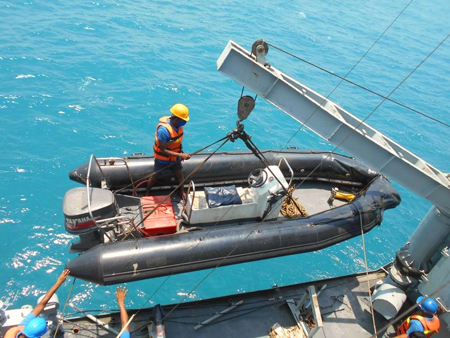 Damage control rounds are done every two hours to ensure the highest operating standards of safety at sea. A key drill on all naval vessels is the MOB - Man Overboard - a drill that indicates a sailor who accidentally falls into the water. Once alerted, the bridge will rapidly alter the sailing direction to a 60 degree “hard over to port” turn.
Damage control rounds are done every two hours to ensure the highest operating standards of safety at sea. A key drill on all naval vessels is the MOB - Man Overboard - a drill that indicates a sailor who accidentally falls into the water. Once alerted, the bridge will rapidly alter the sailing direction to a 60 degree “hard over to port” turn.
This is done to avoid the fallen sailor being sucked into the ship’s rotating propeller which can be fatal. There are life rafts that automatically inflate when released and can hold up to 50 sailors during a major emergency. A 24-hour sickbay has two qualified naval paramedics on duty.
We entered the Bridge (wheelhouse) of the vessel. This is where the captain sits and directs his team of navigators. The navigation officer also makes an important contribution. He showed me an array of compasses, GPS systems and radars. In addition, this Offshore Patrol Vessel has a chart room where the ship’s course is prudently plotted using sea maps. The trustworthy sextant is still used to locate nautical bearings. During the voyage, the officers take turns working as the OOW - Officer of the Watch. For this, they must be competent in the subject of Bridge Watch Keeping. Above the bridge is the bridge top, a section that offers an extended view and houses the antenna mast. Sentries are posted here at times to enhance visual observation using long-range binoculars.
The communication department ensures that P-622 is connected to her Shore Command and other naval vessels at sea. The Sri Lanka Navy uses a system of 69 flags and pennants to express a set of messages. The quartermaster uses his whistle to blow signals that transmit messages to the crew (the call is known as piping). At sea, the men need to be fed and morale kept high. The catering and mess crews do an amazing job in a rather confined space, turning out fresh cuisine. The supply officer maintains sufficient stocks for each voyage. The sailors are housed in a mess, according to their ranks and enjoy a reasonable level of comfort. They have access to television and board games. Discipline is maintained at sea by the DI - Drill Instructor. This robust senior sailor’s uniform displays a golden chain-link cord, which shows his rank. Naval vessels are loaded with such British sailing customs. Another naval tradition is proudly observed during the New Year. On December 31, the ship’s bell is rung by the youngest sailor 16 times. He will ring the bell eight times to ring away the old year and eight times to herald in the New Year. The gallant officers and sailors of SLNS Sagara (P-622) continue their deep sea patrolling and are a vital link in the chain of Sri Lanka’s maritime defence.
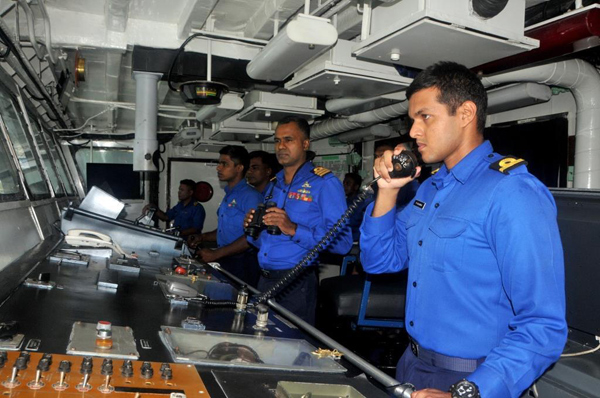
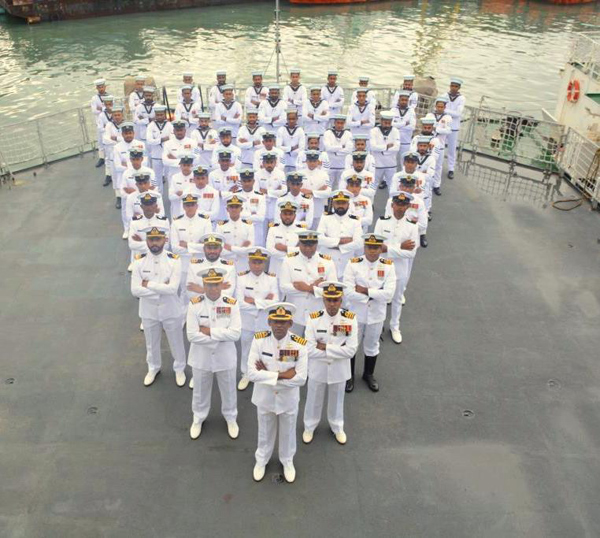
Courtesy - dailynews.lk